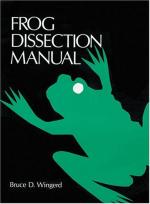|
This section contains 2,282 words (approx. 8 pages at 300 words per page) |

|
Frog Dissection
Summary: Provides a description and differences between a frog and human on different topics including: eye, mouth, skin, circulatory system, respiratory system, digestive system, reporductive system (male and female), and fat bodies.
A very unique characteristic of the frog is its eye. The eye of a frog is very critical because they are terrestrial and aquatic. When they are out of the water, the eyes function basically normal in comparison to other animals, but they must adapt when they are in the water. When they are in aquatic environments, they must be able to defend themselves and be aware of predators in the water. The eye is made up of the cornea, pupil, iris, and nictitating membrane. The cornea is the outer layer of the eye. The pupil is the opening for light rays. The iris is the colored part of the pupil. The structure that allows the frog to instantly adapt and see under water and out is the nictitating membrane. The nictitating membrane is a transparent movable membrane that protects the eye when it is visualizing. Unlike a...
|
This section contains 2,282 words (approx. 8 pages at 300 words per page) |

|


